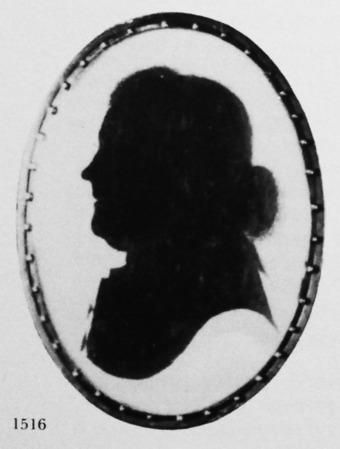Thomson, William John (McKechnie Section 5)
Not previously recorded as a silhouette artist. Although the trade label on the illustrated example describes the artist simply as ‘Mr. Thomson’, the address is the same as that on the reverse of a portrait miniature painted by William John Thomson, the well known portrait miniaturist (recorded by Foskett) who is now known to have been a profilist also. The miniature in question (illustrated by Foskett) is inscribed on the reverse ‘Painted by W. J. Thomson, 212, Piccadilly, March, 1807.’
Thomson was born in Georgia, in the United States. His father, a government official, lost his post during the War of Independence and emigrated to England, bringing his son. It may have been W. J. Thomson who exhibited a ‘Principal front of a stable’ at the Royal Academy in 1795. He certainly exhibited at the British Institute (he is listed by Graves), the Old Water Colour Society, the Associated Artists and the Society of British artists, 1796-1843. He may have been the W. J. Thomson who entered the Royal Academy Schools on 21 January 1808, at the age of thirty-five (if so, he would have started work as a miniature painter and as a profilist before entering the Schools). In this year he was apparently considered for election as a member of the Royal Academy. He had become a member of the Associated Artists on 29 July 1807, and continued a member until 1809.
Thomson’s family home was in Edinburgh, where he had married in 1797. His marriage is recorded as follows (Scottish Records, Grant, 1922): ‘Tron Parish, md. 12. 5. 1797, at Edinburgh, Miss Helen Colhoun of Tron Parish, Dau. of Captain James Colhoun of the Army’.
After his spell in London, at least part of which he spent at 212 Piccadilly, Thomson returned in 1812 to Edinburgh. There he exhibited at the Edinburgh Association of Artists in 1813, at the Edinburgh Exhibition Society in 1814-15, at the Institute for the Encouragement of the Fine Arts in Scotland 1821-30, and at the Royal Scottish Academy (of which he became a member in 1829) 1830-43. At this time he was painting portrait miniatures, portraits, landscapes and genre subjects; it seems unlikely that he painted silhouettes after he had left London.
He declined the offer of a knighthood. In 1820 he was living in Edinburgh at 20 Dundas Street. He died on 24 March 1845 in Northumberland Street.
A number of his miniatures are in private collections in Scotland; one is in the Victoria and Albert Museum, London (a portrait of Catherine, Lady Blantyre, painted in Edinburgh in December 1812). Another portrait, also painted in Edinburgh (1815) is in the Kunstgewerbe Museum, Dresden.
Notable features of the illustrated silhouette (of a man, and framed in a locket) are the sharpness of the terminating points at the bust and at the edge of the sitter’s collar, the sitter’s very long, thin eyelash, and the definite indication of the shaft of the button as well as of its shape.
Attached to the locket is a small rectangular printed label which reads: ‘Ptd. by Mr. Thomson/No. 212, Piccadilly, London.’
Ill. 1516

Gold locket, containing a silhouette of an unknown man painted on ivory by W. J. Thomson, c. 1807.
The oval is surrounded by a border representing spurs. Size of locket: 1 ¼ x 7/8 in./32 x 23mm.
M. A. H. Christie collection
